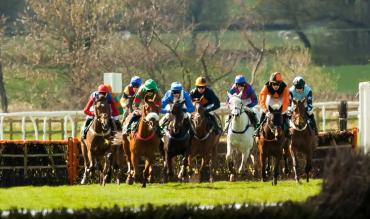There are currently three racecourses in Wales.
Geographically the country has Bangor-On-Dee Racecourse in the north, just across the border from its sister course - Chester, as well as Ffos Las in the west and Chepstow in the south. Ffos Las is Britain’s most westerly racecourse.
Welsh Racecourse List:
- Chepstow Racecourse (Monmouthshire)
- Bangor-on-Dee Racecourse (Wrexham)
- Ffos Las Racecourse (Kidwelly)
Bangor-on-Dee stages jumps racing only, while both Ffos Las and Chepstow are dual-purpose venues hosting both flat and jumps meetings all year round. Al three venues are popular in the horse racing betting.
Chepstow Racecourse
Chepstow Racecourse is an undulating 270-acre course on the outskirts of town. The first race meeting held in Chepstow was in 1926. Chepstow is within easy reach of the Severn Bridge that links Wales with England.
Chepstow is best known for the annual Welsh Grand National which takes place between Christmas and New Year. The event takes place on 27 December every year.
The race features the most recognisable owners, trainers and jockeys in jump racing and was even the subject of a worldwide feature film called “Dream Horse”.
Dream Horse is the incredible story of how a horse (Dream Alliance) that was born on an allotment bought for £300 and went on to win £138,000 in prize money.
Breeders Brian and Jan Vokes began a 23-strong racing syndicate in the Cefn Forest Working Men’s Club, forming what they dubbed a dream alliance. The aptly-named horse went on to win five out of 30 races including the Welsh Grand National in 2009.
Bangor-on-Dee Racecourse
Bangor-on-Dee Racecourse is on the north east borders of Wales. There are 14 exciting jump racing fixtures each year on the banks of the River Dee.
The first steeplechase meeting was held at Bangor in February 1859 and the course has changed very little since then.
Bangor-on-Dee is the only racecourse of its kind in the country without a grandstand, with views of the racecourse coming from a large grassy embankment.
A timeline depicting some of the key moments from Bangor’s illustrious history was created in 2019 to celebrate 160 years of racing. The timeline is on display in the Wynnstay building.
Ffos Las Racecourse
Ffos Las is the most recent addition to Wales' racing portfolio.
The track was opened in 2009 on the former site of Europe's largest open cast coal mine but you’d never know that carbuncle even existed with the Carmarthenshire Gwendraeth Valley now a picturesque rural setting for the horse racing.
In 2018, Ffos Las was bought by Arena Racing Company (ARC) from the founder, Dai Walters.
Interestingly, as it is close to two ports offering Irish ferry services, Ffos Las draws in many promising Irish horses and their supporters for both the flat and jumps races. The Irish horses are always worth keeping an eye on in the betting.
As the course is level and about a mile-and-a-half for a full lap, there is an emphasis on speed for the flat races.
During the winter months, however, deep ground in West Wales means horses need plenty of stamina to succeed in the jumps events at Ffos Las.
Welsh Racehorse Trainers:
-
Peter & Michael Bowen – Haverfordwest, Pembrokeshire
-
Rebecca Curtis – Newport, Pembrokeshire
-
David Evans – Abergavenny, Monmouthshire
-
Grace Harris – Shirenewton, Monmouthshire
-
Ronald Harris – Chepstow, Monmouthshire
-
Bernard Llewellyn – Pentwyn, Bargoed
-
David Rees – Dyfed, Pembrokeshire
-
Sam Thomas – Lisvane, South Glamorgan
-
Tim Vaughan – Cowbridge, Vale of Glamorgan
-
Christian Williams – Ogmore by Sea, Bridgend
-
Evan Williams – Llancarfan, Vale of Glamorgan
*Credit for all of the photos in this article belongs to Alamy*


